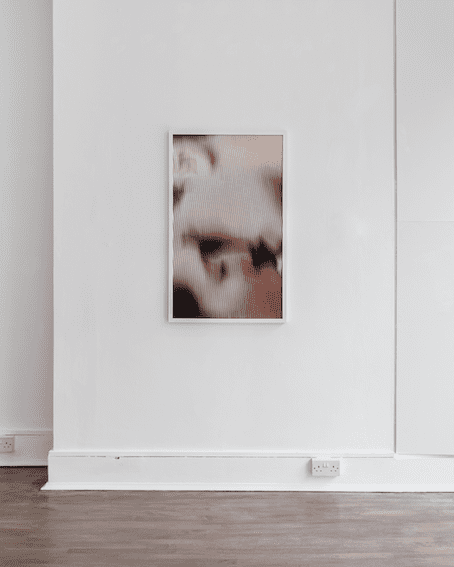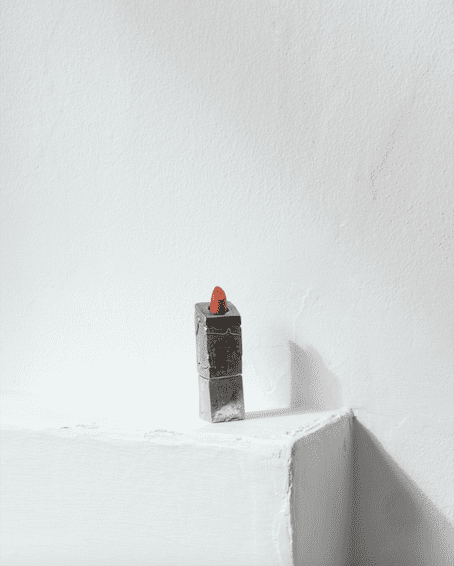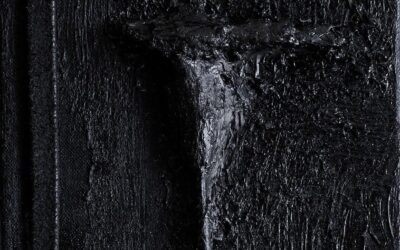Interacting with physical surfaces, both skin and fabric, was a source of contention during the pandemic—a site of discomfort and sensitivity around the transference of germs. In the years following the formalised parameters of viral transmission, the body is a reminder of that cautious time in recent memory. Academic surveys report that Gen Z are having less sex than previous generations, abandoning nightlife and revelry in favour of home comforts. As a population, we are stuck to our phones, even when trying to broach the topic, and practice, of forming relationships. All of the above generates an instilled, and inescapable, alienation from each other and from our immediate surroundings.
The art world, and its institutions, has always been a staunch advocate of alienation between who we are as people and who we are in the gallery space; look, but for the love of god, do not touch. Don’t breathe too close. And try not to wear anything too casual, otherwise risk a sense of suspicion.
Anything can be ascribed and imbued with meaning when, as an individual subject, the viewer has neither a personal contribution nor a stake
Surface Tension, a group exhibition held at London gallery Des Bains and curated by Anastasia Chugunova, is a showcase of four international up-and-coming artists who feed off this concoction of alienation, and who desire to break it, in ways both delicious and disgusting.
To be validated in life, all must be documented online, and everything we consume online becomes our lives and shapes our perceptions. We embody the virtual world so much that the call to engage with the sense of touch can be disarming. Nevertheless, as with every exhibition one visits in the twenty-first century, recalling artworks seen in Surface Tension is achieved in the space between memory and flicking through iPhone photos.
However this is where the schism between real experiences and those from a mobile phone emerge; documentation imagery of Des Bains appears sparsely curated, but within the space there is a tingling energy of sensory anticipation, highlighting not only a skilled curation by Chugunova, but a vitality in the works.
Installation-cum-sculptural works by London-based artist Isabella Benshimol Toro feel like they are straight from the hands of an “artist to watch” hot list. It would not be surprising to see Toro hailed as the Gen Z Tracey Emin, or Sarah Lucas.
The first is Painting about blushing, an installation pleasingly built into the alcove of the wall space. Using toughened glass, prosthetic silicone and towels, the mundane is transformed into both high art and quiet stillness. Depicting discarded towels, there is undoubtedly an air of Emin, however the silicone hardening of this material abandonment freezes the moment in time. The ‘moment’ itself is deeply inconsequential, but the story being told in Surface Tension is that, objectively speaking, so much of what one does and feels will seem this way to an unattached viewer. They will not feel the same sensation, whether emotionally or literally, as the artist or subject.
Another of Benshimol Toro’s works, freefall, a large print in the window of Des Bains, backs out onto the busy traffic of the street. The public alienation of the commute, absent-mindedly walking through the busier parts of the city, and meandering among strangers, is rendered tense alongside the artwork, depicting what could be twisted—again discarded—underwear.

The story being told by the object in the photograph is purely up for interpretation, steered by the viewer’s own experiences and desires at the sight of this symbolic, implied nudity. The fragment in question is not necessarily gendered, nor even designed in an especially provocative manner, but the expectation that it potentially belongs to a woman in a rush elevates the impact of the image. This intensely private vignette feels spontaneous and energised by an almost chemical urgency, perhaps lust, but in predicting the circumstances around this lingerie being removed, the viewer is again lurched back into their own alienation, distinctly separate from the action.
A similar affect is presented in the work of Lithuanian artist Deividas Vytautas. Softcore (bedroom scene) presents a visually compelling division and separation of a still image extracted from pornography, which itself has been alienated and stripped of context.

Anything can be ascribed and imbued with meaning when, as an individual subject, the viewer has neither a personal contribution nor a stake. To the outside eye, which we each possess, Vytautas’ scene could be romantic, staged, candid; the very use of the image could be in breach of the subjects’ consent. We are compelled to engage with the work, and our senses, as much as capacity allows, but there are hard and pragmatic limits to this which transcend all works in the show.
Surface Tension, ultimately, is the epitome of exhibition-making in the post-digital age. It is effective on Instagram, especially with the works of Vytautas and Benshimol Toro. It lures the viewer in with promises of sensory stimulation, but throws the individual back into themselves with the age-old mechanisms and power dynamics; you are worthy of sharing space with the artworks, but no more. Camille Yvert’s pocket-sized lipstick sculpture—that one almost walks straight past—exudes femininity and dagger-like danger in tandem.

The desire to touch is palpable throughout; where social bonds and physical intimacies lie in tatters, it is the materialist drive that pushes the viewer in Anastasia Chugunova’s latest curatorial project. Sculptures and wall-based works radiating a consumerist sex appeal, one only sated once ownership has been acquired.
SURFACE TENSION, Camille Yvert, Beatrice Vorster, Deividas Vytautas, Isabella Benshimol Toro
curated by Anastasia Chugunova, at Des Bains, 23 march 2024 – 14 April 2024.
All images courtesy of Des Bains, Anastasia Chugunova, and the respective artists.

Issey Scott is an arts and culture writer and sometime-curator based in London. She has produced texts for exhibitions in the UK, USA and Italy, and her by-lines include RIBA and The Big Issue. She is fascinated by the post-digital urge to transcend the body

















